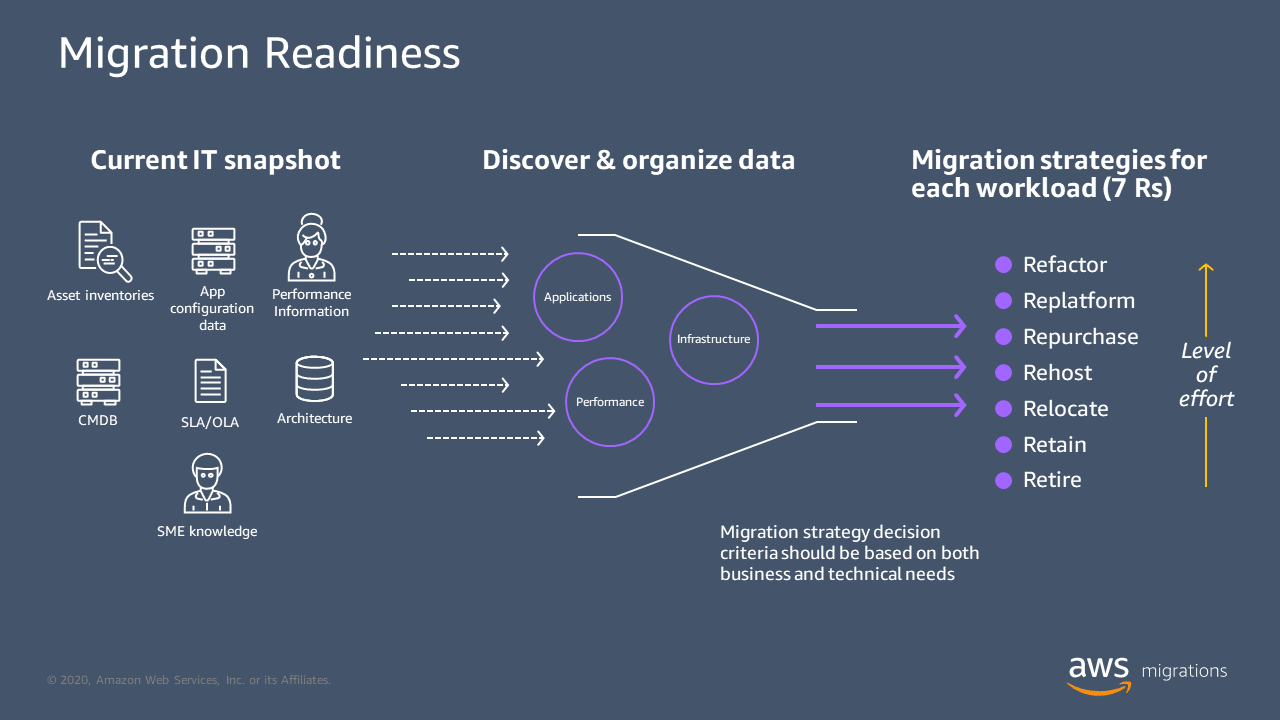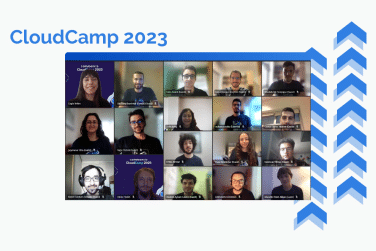Ensuring Seamless Transitions: Key Best Practices for Evaluating Retiring Applications in AWS Migrations
Ensuring Seamless Transitions: Key Best Practices for Evaluating Retiring Applications in AWS Migrations
This guide provides best practices for handling retirement applications in an Amazon Web Services (AWS) cloud migration plan. It emphasizes the importance of collecting application portfolio data, evaluating it against the seven common migration strategies (7 Rs), which include refactor, replatform, repurchase, rehost, relocate, retain, and retire.
Once the initial portfolio analysis is complete, an initial migration plan is formulated for each application to ensure a smooth transition to retirement within the AWS Cloud environment. This plan should be continuously optimized based on lessons learned and new data acquired during the migration process, ensuring a systematic and effective retirement process for applications.
This guide highlights the challenge of deciding whether to retire applications due to complexity and potential risks, often exacerbated by the departure of subject matter experts and limited documentation for legacy systems. Nevertheless, retiring unused applications is crucial for a stronger business case and efficient resource allocation. It presents six best practices for assessing applications for retirement within your migration strategy.
Outcomes that target business objectives
Assigning migration strategies to applications may reveal that some can be retired, saving resources and reducing complexity. Retiring unused applications can lead to cost savings, streamline operations, and focus efforts on valuable systems. However, it carries risks due to limited legacy system knowledge and potential hidden dependencies. To mitigate these risks, understanding upstream dependencies is crucial. The guide’s six best practices and data-driven approach help make informed decisions when retiring applications.
Assess Your Current Environment
Migrating to the cloud is a significant undertaking for any organization. It often involves the complex process of moving workloads, data, and applications to a cloud environment like Amazon Web Services (AWS). One important aspect of this journey, especially for large-scale migrations, is the establishment of a migration factory.
In the realm of large-scale cloud migrations, setting up a migration factory is a game-changer. This “factory” comprises teams, tools, and processes that work together to optimize migrations systematically, learning from each phase’s successes and challenges. It applies proven patterns to expedite workload migrations and enhance overall outcomes.
The decision to implement a migration factory hinges on the size of your IT portfolio, offering particular advantages for extensive migration projects. By adhering to a phased approach that prioritizes less critical applications, migration teams accumulate valuable experience for seamless transitions. Prior to assessments, capturing one month of dependency data for retiring applications is essential. Application owners can then analyze these connections, fostering a smoother migration process.
In essence, a migration factory is a strategic approach that optimizes and accelerates large-scale AWS cloud migrations, ensuring efficiency, adaptability, and a successful transition to the cloud.
Early in the migration process, identify and retire applications
An important aspect of your migration strategy is to identify and retire applications early in the process. Delaying this step risks leaving insufficient time for inclusion if it becomes necessary later. Early retirement lightens the workload for maintaining teams, allowing them to focus on the migration itself. Additionally, following best practices over an extended period provides flexibility to adjust the migration plan and include applications in future waves if needed.

Avoid disruptions by being data-driven and using discovery tools
Ensuring a smooth migration process involves adopting a data-driven approach when considering the retirement of applications. Relying solely on outdated documentation can lead to unexpected challenges, such as applications becoming dependent on systems without formal engagement.
To avoid potential disruptions, it’s essential to assess dependencies systematically. Start by monitoring inbound and outbound network connections on retirement servers. This will help identify potential upstream dependencies, especially those related to workloads scheduled for migration. AWS offers tools like the Application Discovery Service to aid in this process, providing insights into which applications rely on servers marked for retirement. For instance, if a server has connections from management servers (usually harmless), but also connects to applications within the scope of migration, a deeper analysis is needed to understand the impact on those applications.
The use of data-driven decision-making during migration allows for informed decisions, minimizes risks, and ensures a smoother transition.
Establish a controlled stop schedule
In your migration strategy, it’s vital to plan for controlled stops to assess potential disruptions when retiring applications. A controlled stop temporarily halts the migration, simulating the application’s retirement, and allowing observation of its effects. This approach can involve tactics like implementing a host-based firewall to block traffic, pausing virtual machines, stopping services, or using an external firewall to block all traffic.
The duration of the controlled stop should be determined by the migration project and application owners, considering factors like the application type and its frequency of use. For example, if you’re retiring a batch-based workload that runs infrequently, a one-week controlled stop might not suffice to gauge its impact. By conducting controlled stops, you can make informed decisions about application retirement based on observed service disruptions or interruptions.
Evaluate whether the application should be migrated
As you assess the application retirement process, it’s crucial to consider the potential impact on upstream business operations. If best practices reveal concerns or dependencies, reevaluating the application’s migration plan is essential. Initiating the retirement process early provides the flexibility to incorporate the application into a future migration wave if issues or dependencies arise. If you remain uncertain about retiring the application after following these best practices, contemplate the possibility of rehosting it on the AWS Cloud, especially if your migration has a set endpoint like a data center lease expiry. AWS Application Migration Service simplifies the rehosting process. During migration, taking daily snapshots of Amazon Elastic Block Store (Amazon EBS) volumes and terminating Amazon Elastic Compute Cloud (Amazon EC2) instances can reduce costs and facilitate extended testing of the application’s retirement. In case of any impact or issues, you can confidently recreate EBS volumes from the snapshot to resume the EC2 instance.
End the application's lifecycle
Following the five best practices outlined in this guide, you may have determined that it’s safe to retire an application as part of your migration strategy. After making this decision, it’s essential to consider whether the application contains valuable data for future use, particularly in the context of machine learning and analytics. Historical data can hold significant future value, even if you’re not currently developing machine learning algorithms. Additionally, regulatory or compliance requirements might mandate data retention, even after application retirement.
AWS provides a robust suite of cloud storage services designed for long-term data retention, compliance, and digital preservation. These solutions offer scalability, exceptional durability, data reliability, and robust security measures. AWS also regularly attains third-party validation for various global compliance requirements, ensuring that your data remains secure and compliant with industry standards.
Key Takeaways
This guide has presented six key best practices for application retirement within your migration plan. These practices offer a foundational framework for assessing the impact of applications scheduled for retirement. While customization may be necessary to align with your organization’s specific processes, such as tracking retired infrastructure in your configuration management database, this framework effectively streamlines the migration workstream. By adhering to these guidelines, you can retire applications with confidence, build trust in the process, and allow ample time for any necessary adjustments to applications that may have been initially misclassified.
Commencis is an AWS Advanced Consulting Partner that helps organizations develop Cloud Native Applications. Our Cloud team has a deep understanding of the framework and can help organizations implement it in a way that meets their specific needs. Contact our cloud experts to enable cloud workload efficiency in your business.
Reading Time: 5 minutes
Don’t miss out the latestCommencis Thoughts and News.




